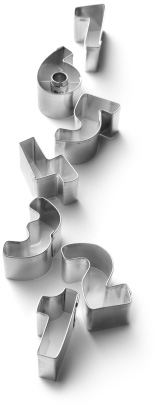Cookie Cutter History
At some point in time somebody realized that circles were just too common a shape for all cookies. Cookie Cutters were the solution, but how did they come about? Here are just a few bits of information on the history of cookie cutters for your enjoyment.
The modern day cookie cutter was not invented by one individual, but rather has evolved over time. In fact, you can go back as early as 2000 B.C. and find Egyptian ceramic or wooden baking molds that were used to bake up biscuits or cakes. Even back then they yearned for a bit more creativity, though pink frosting and rainbow sprinkles were still a ways off!
Fast forward to the 16th century and we see the popularity of the gingerbread man start to rise. Documented history accounts for the first gingerbread biscuits making an appearance in the court of Queen Elizabeth I of England. Apparently she had these cookies made as miniature, edible replicas of some of her more esteemed guests. Off with their heads! (and arms and legs... and gumdrop buttons.) As these gingerbread cookies started to become popular requests from bakeries in the 1600's, bakers started using tin cookie cutters to expedite the process of cutting them out.
As Europeans migrated to the United States, so did some of their trends and customs, including the gingerbread man cookies and the cookie cutters used to make them. It wasn't long before American tinsmiths started manufacturing the cutters (in several shapes and sizes) and making them available to the general public. By the 1800's tin cookie cutters were being sold from shops and peddlers.
By the mid 1800's commercial machinery had developed in both the United States and Europe to the point that all sorts of products were moved from being hand-made to manufactured in factories. By the turn of the century several manufacturers were creating and distributing cookie cutters in this fashion, offering them in catalogs, advertising them, and even importing them from other countries.
While tin had been the primary material for cookie cutters, they started being made from other materials as they became more available. During the first half of the 20th century we saw aluminum and plastic being used.
Cookie cutters continued to grow in popularity as more designs were being made. During the 1970's and into the 1980's more people became domestic and worked on their own crafts at home, including decorated cookies. During this time we also saw an increase in spendable income, allowing people to spend more on such hobbies. As with many other products, there was a trend during the last quarter of the century to make manufacturing cheaper and cheaper, and more cookie cutters were being made in the likes of China and Malaysia. However, cookie cutter production somehow survived being moved completely out of country and there are still a good number of cutters being made in the United States.
Today you can find cookie cutters in just about any shape or size. Copper is now a popular material for cookie cutters, but plastic and tin are still the most commonly found. If you can't find a particular shape, there are cookie cutter manufacturers that will create a custom shape for you. You can also buy your own kit to design and create your own cutter as well.
While cookie cutters are being bought for the obvious purpose of cutting out sugar cookies, there is also a large number of people that search for, bid on, and buy cookies simply to collect them. There is even an official Cookie Cutter Collectors Club (CCCC) that meets regularly and has a big following. There are at least a couple of Cookie Cutter Museums, and enthusiasts even enjoy a "National Cookie Cutter Week" (started by the CCCC) during the first week of December. Of course this marks the beginning of the biggest time of the year for decorating cookies: the Christmas season. Even if you don't care for the holiday, who can resist biting into a yellow frosted star cookie?


